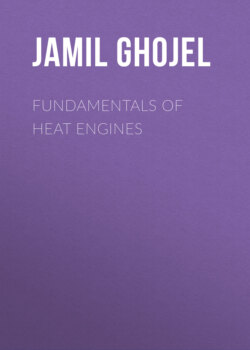Читать книгу Fundamentals of Heat Engines - Jamil Ghojel - Страница 17
1.1.2 Newton's Laws of Motion
ОглавлениеAccording to the first law, the momentum of a body keeps it moving in a straight line at a constant speed unless a force is applied to change its direction or speed.
The second law defines the force that can change the momentum of the body as a vector quantity whose magnitude is the product of mass and acceleration:
(1.1)
Another form of this law that is particularly pertinent to gas turbine practice states that force is equal to the rate of change of momentum or mass flow rate multiplied by velocity change dv (the letter v will be used for velocity exclusively in the mechanics section of this chapter):
(1.2)
For an aircraft engine, the air flow into the engine diffuser is equal to the forward flight speed v1, and engine exhaust gases accelerate to velocity v2 in the engine nozzle. For a mass flow rate of the gases, the thrust is therefore .
In heat engines, it is often necessary to use vector algebra to resolve the acting forces to determine the forces of interest that can produce work. For example, the pressure force of the combusting gases in the piston engine, which is the source of cycle work, does not act directly on the crank, as a result of which parasitic forces are generated, causing undesirable phenomena such as piston slap. Resolving the forces at the piston pin determines the force transmitted through the connecting rod to the crank, generating a torque. In a gas turbine, the gas force generated during flow through the blades has a component acting parallel to the turbine axis that causes bearings overload and needs to be balanced to prevent axial displacement of the rotor.
The third law simply states that ‘for every force there is an equal and opposite reaction force’. In an aircraft jet engine, the change in momentum of a large flow rate of gases between the inlet and outlet of the engine generates a backward force known as thrust, which has an equal reaction that propels the aircraft forward.
